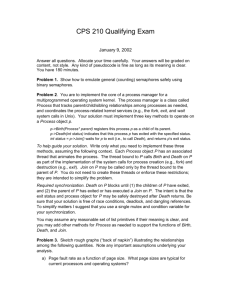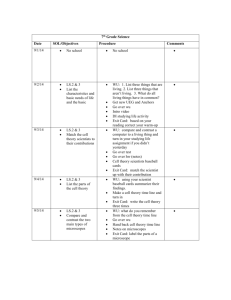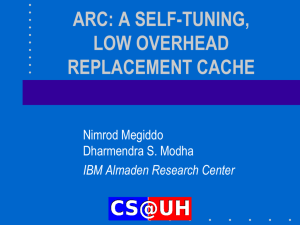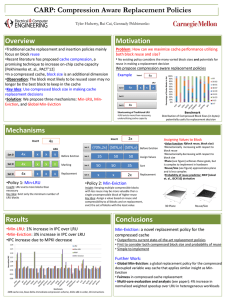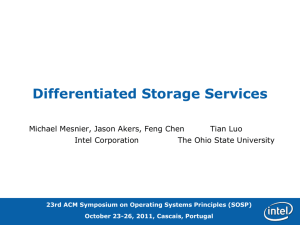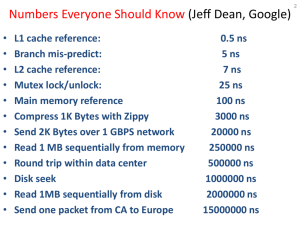final-98s
advertisement
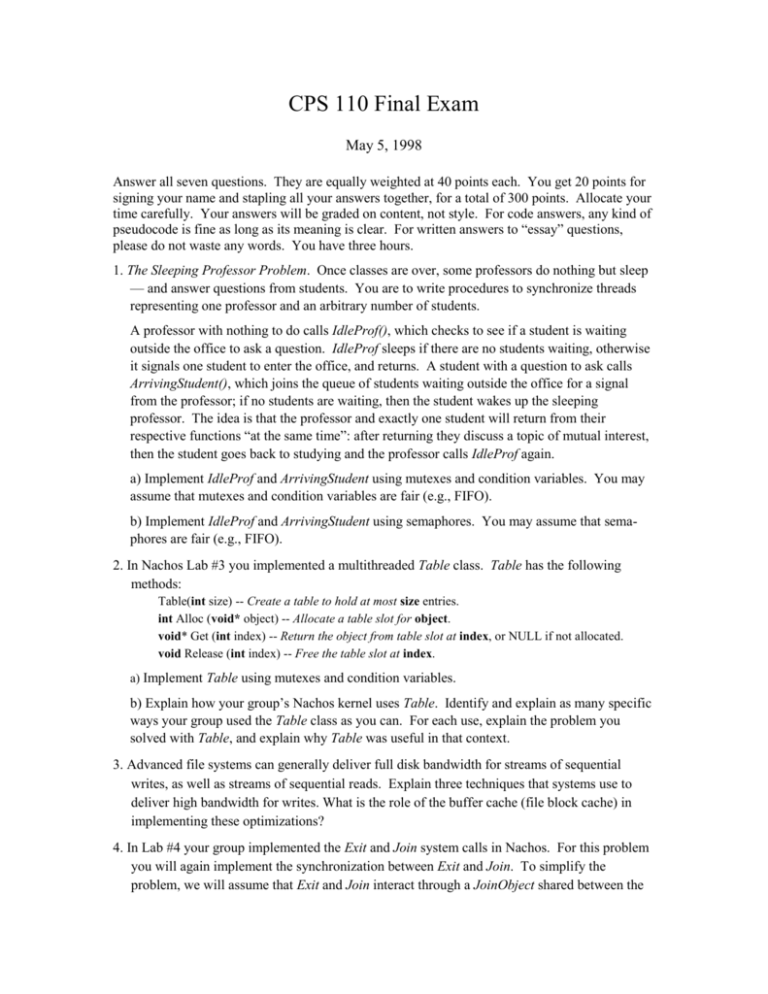
CPS 110 Final Exam May 5, 1998 Answer all seven questions. They are equally weighted at 40 points each. You get 20 points for signing your name and stapling all your answers together, for a total of 300 points. Allocate your time carefully. Your answers will be graded on content, not style. For code answers, any kind of pseudocode is fine as long as its meaning is clear. For written answers to “essay” questions, please do not waste any words. You have three hours. 1. The Sleeping Professor Problem. Once classes are over, some professors do nothing but sleep — and answer questions from students. You are to write procedures to synchronize threads representing one professor and an arbitrary number of students. A professor with nothing to do calls IdleProf(), which checks to see if a student is waiting outside the office to ask a question. IdleProf sleeps if there are no students waiting, otherwise it signals one student to enter the office, and returns. A student with a question to ask calls ArrivingStudent(), which joins the queue of students waiting outside the office for a signal from the professor; if no students are waiting, then the student wakes up the sleeping professor. The idea is that the professor and exactly one student will return from their respective functions “at the same time”: after returning they discuss a topic of mutual interest, then the student goes back to studying and the professor calls IdleProf again. a) Implement IdleProf and ArrivingStudent using mutexes and condition variables. You may assume that mutexes and condition variables are fair (e.g., FIFO). b) Implement IdleProf and ArrivingStudent using semaphores. You may assume that semaphores are fair (e.g., FIFO). 2. In Nachos Lab #3 you implemented a multithreaded Table class. Table has the following methods: Table(int size) -- Create a table to hold at most size entries. int Alloc (void* object) -- Allocate a table slot for object. void* Get (int index) -- Return the object from table slot at index, or NULL if not allocated. void Release (int index) -- Free the table slot at index. a) Implement Table using mutexes and condition variables. b) Explain how your group’s Nachos kernel uses Table. Identify and explain as many specific ways your group used the Table class as you can. For each use, explain the problem you solved with Table, and explain why Table was useful in that context. 3. Advanced file systems can generally deliver full disk bandwidth for streams of sequential writes, as well as streams of sequential reads. Explain three techniques that systems use to deliver high bandwidth for writes. What is the role of the buffer cache (file block cache) in implementing these optimizations? 4. In Lab #4 your group implemented the Exit and Join system calls in Nachos. For this problem you will again implement the synchronization between Exit and Join. To simplify the problem, we will assume that Exit and Join interact through a JoinObject shared between the joiner and the joinee. The JoinObject class provides two methods Exit and Join that are called by the Exit and Join system calls respectively. JoinObject::Exit takes the exit status as an argument, and JoinObject::Join returns the exit status. a) Implement JoinObject::Exit and JoinObject::Join using mutexes and condition variables. b) Outline a scheme for using the JoinObject class to implement the Exit and Join system calls in Nachos. When will JoinObjects be created and destroyed? How will the kernel get a pointer to the right JoinObject in the Exit and Join system calls? 5. Explain in detail what happens when a Nachos user program running above your kernel executes a load or store instruction. Be sure to explain how virtual addresses are translated, and consider what happens if the user program references an illegal address or incurs a page fault. You do not need to consider page frame allocation, eviction, or replacement. Don’t worry if you are not familiar with the details of the Machine simulation in Nachos: just assume that Machine behaves like some reasonable computer architecture, and explain any assumptions you make about it (e.g., how the TLB works). 6. Most “real” operating systems use variants of Least Recently Used (LRU) as a replacement policy for the file block cache (buffer cache) and the virtual memory system (page cache). a) What is the rationale for choosing LRU as the replacement policy in each case? b) Outline how to implement LRU replacement for the file block cache. Consider the handling of dirty blocks. c) In general, a direct implementation of LRU is not practical for the virtual memory page cache. Explain why this is so. d) Outline how to approximate LRU replacement for the virtual memory page cache using the FIFO-with-second-chance algorithm. What parameters does the algorithm use to balance the quality and cost of the LRU approximation? 7. Describe the most interesting bug your group encountered during the semester. Which of your group members do you think will give the best answer to this question?


